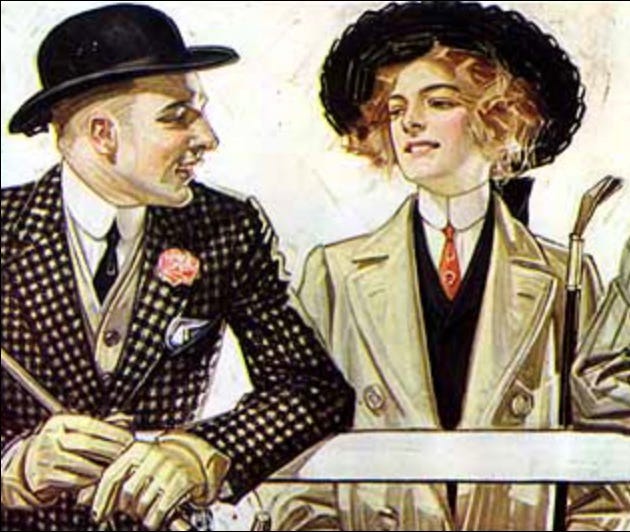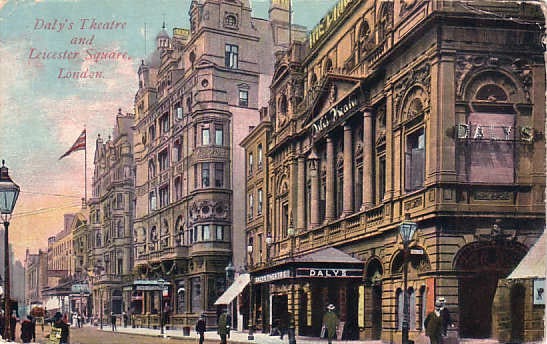When Kate and Ernest failed
Not one, but two private detectives, including one of the best known female detectives around, were employed to find evidence of adultery in an Edwardian case. They failed to do so.
Today, I am returning to the Blairs - the married couple who both worked as private detectives. Last week, I looked at Lilian Blair; today's case focuses on her husband, Ernest, who spent longer than his wife as a private detective.
The newspaper report started with a dramatic statement. Mrs Phoebe Miller had stood up in the Divorce Court in London to point at a figure in a doorway. "There is my husband!" she declaimed, seeing the man she had just accused of cruelty and misconduct standing at the far door of the court. Accordingly, "There is my husband!" became the headline in the story about Mrs Miller's plea for a divorce.
Ten years earlier, in 1899, Phoebe Moncrieff Maclachlan had married James Hillman Miller. It sounded like a good match on paper. Phoebe was the eighth child of William Maclachlan, a Scottish man who had had a variety of careers, from sea captain to mining engineer to merchant. Her husband was a stockbroker, son of the secretary of the Church Association. The couple were in their early 20s when they wed.
James and Phoebe Miller’s marriage lasted a decade
Three years after their marriage, their only child, Terence, was born. They had lived in Fulham, in a nice flat, and were comfortably off. Sadly, though, they did not get on. Their daily lives were punctuated by quarrels and 'bickerings', which were almost constant. Phoebe had to deal with her husband's bad temper and his neglect. They rarely agreed on anything, and "I didn't satisfy him", she would later complain.
James Miller would threaten to hit his wife, and to evict her from their flat. On one occasion, he tried to throw her out, and she had to ring the servants' bell to get her cook to come and rescue her. This particular fight had stemmed from Phoebe wanting to read a book; James had grabbed it from her, and when Phoebe went to take it back, he threw her on the floor, ripping the skirt of her dress and bruising her arm.
On 7 January 1909, Phoebe locked her bedroom door and refused to let her husband in. James made so much noise, however, that she finally opened the door; his response was, "How dare you shut me out of my boy's bedroom!" He then threatened to throw her out of the flat again. Phoebe had had enough, and 13 days after this event, she filed for a divorce.
In court, Phoebe stated that since November 1908, she had had concerns that James was having an affair. He had first demanded to have a separate bed from his wife, something he had always said he was against. As Phoebe later recounted, "He wished to have nothing more to do with me, and on one occasion later, I taxed him with taking another woman out, and he admitted it."
Proof of adultery was needed, and Phoebe - or rather, her solicitors - had attempted to get this proof. In order to do so, they employed two private detectives to shadow James Miller. One was Ernest George Blair, who had not been working in this arena for very long, and the other, conversely, was one of London's brightest and most talented private detectives - Kate Easton. Despite the disparity in their backgrounds, neither would have success in this case.
Kate Easton had been ordered to 'make enquiries' into James Miller's behaviour. She travelled down to Brighton, where she understood he had been, and, on asking staff at one hotel whether they knew of him, was told that 'Mr and Mrs Miller' were occupying a room there. This all sounded promising, but when Kate went up to the room, she found that 'Mrs Miller' had already gone. Later, lurking at the hotel, she saw James Miller - but he was on his own. This put paid to her shadowings; she had hoped to see 'Mrs Miller' and to engage her in friendly, female conversation in order to get her to admit to a relationship with James.
Once James Miller was back in London, Ernest Blair was commissioned to shadow him around the capital. On New Year's Eve, he saw James drive up to Daly's Theatre; he was in evening dress, and was with a lady who was also dressed up. They emerged from the theatre at 11.20pm, and headed to a restaurant, where they stayed until 4am. It was a long night for Ernest, but he had no proof that James was up to no good - he could simply have been celebrating the New Year with a group of friends, and given the date, the 4am finish was not wholly unexpected.
Private detective Ernest Blair shadowed James Miller to Daly’s Theatre in London
So neither private detective could prove that James Miller had been having an affair, but Phoebe had been able to show that her husband's behaviour had been bad. However, on 24 May, she was issued with a decree nisi, her divorce becoming final in December 1909. Despite the detectives' failure to obtain proof, it seems that James Hillman Miller was indeed having an affair. In early 1910, the ink on his divorce still wet, he remarried, while Phoebe moved into a flat in West Hampstead, near her mother. The 1911 census shows James living with his new wife and his son by Phoebe; later, however, both Phoebe and her son moved to New Zealand. It does not appear that Phoebe ever remarried.
Despite their failure getting evidence for this particular divorce, both Kate Easton and Ernest Blair continued to work as successful detectives for years to come. Kate Easton ran her own detective agency in central London (there is more about her in my book on the history of female private detectives), while, in 1921, Ernest claimed to work for Moser's Detective Agency at 43 Old Queen Street in Westminster.
This claim is complicated by the fact that both Maurice Moser and his one-time partner, Antonia, who were indeed private detectives, but they were both dead by 1921, and Moser's son Gustave, who at one point had helped his father, was working in a different field. Either somebody had decided to use the formerly well-known Moser's name for a new agency, or Ernest himself had taken it. This is something I intend to do a bit more research into - watch this space.



